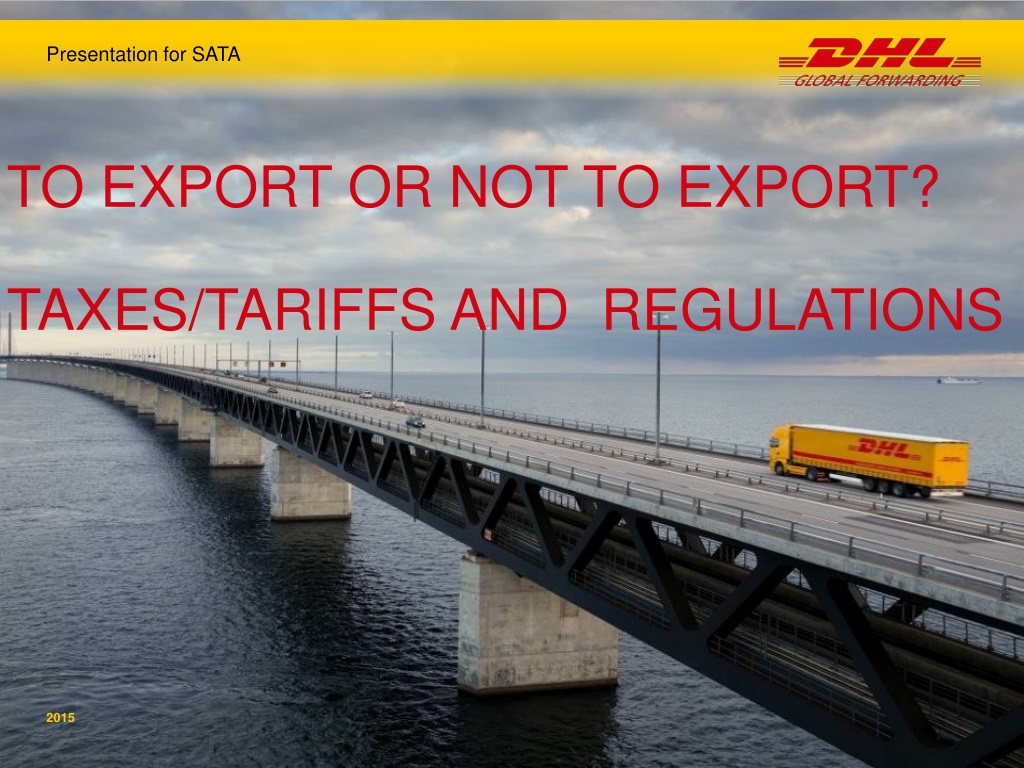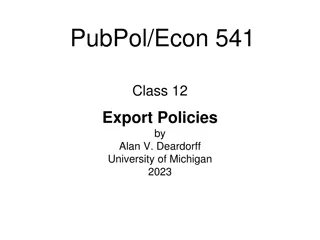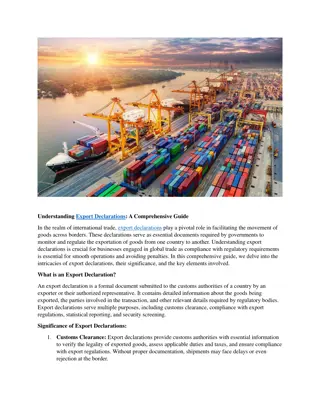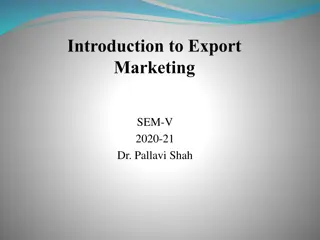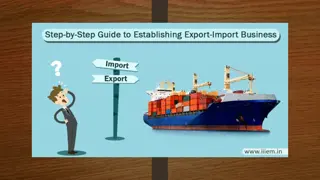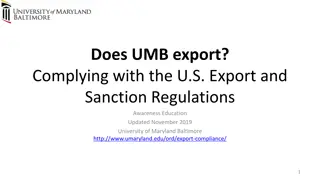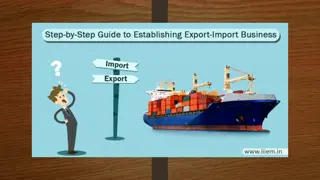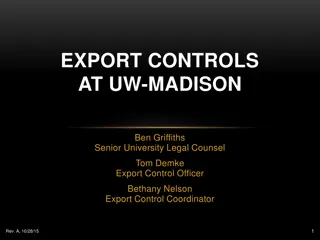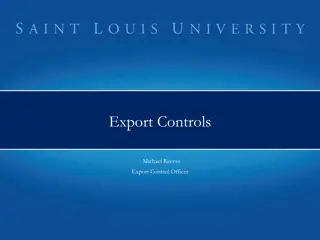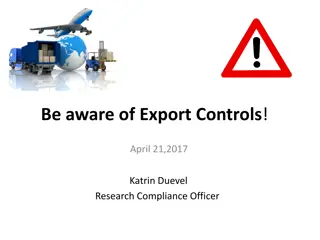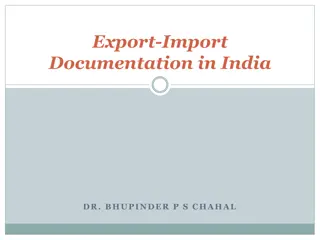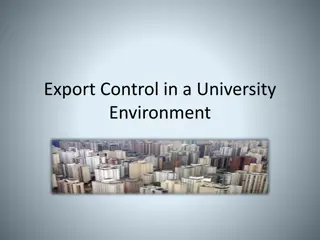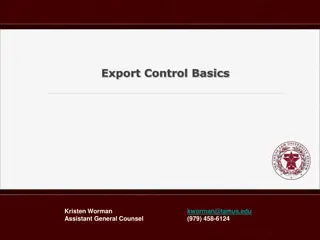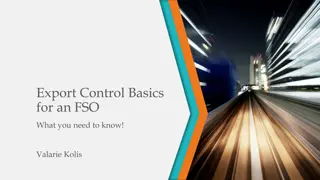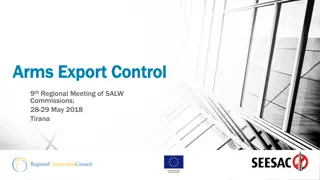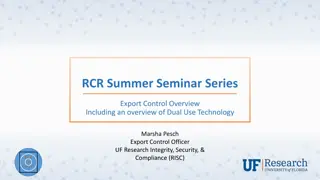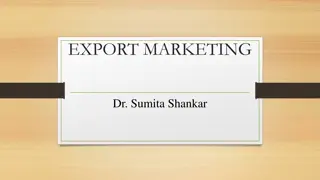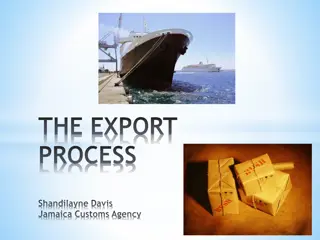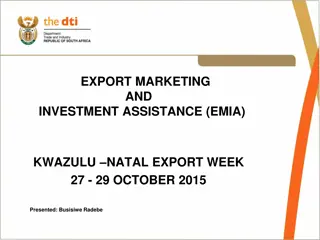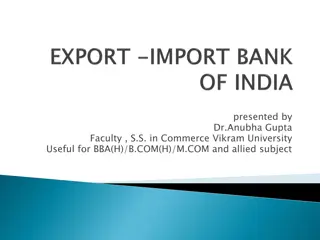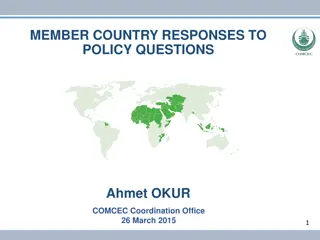Understanding U.S. Export Regulations and Agencies in 2015
Explore the complexities of exporting from the USA in 2015, covering responsibilities of exporters, types of exports, government agencies regulating exports, and an overview of export controls and regulations. Learn about the Bureau of Industry and Security, Directorate of Defense Trade Controls, Office of Foreign Asset Controls, and more. Navigate through the Export Administration Regulations and Foreign Trade Regulations for a comprehensive understanding of exporting from the United States.
Download Presentation

Please find below an Image/Link to download the presentation.
The content on the website is provided AS IS for your information and personal use only. It may not be sold, licensed, or shared on other websites without obtaining consent from the author. Download presentation by click this link. If you encounter any issues during the download, it is possible that the publisher has removed the file from their server.
E N D
Presentation Transcript
Presentation for SATA TO EXPORT OR NOT TO EXPORT? TAXES/TARIFFS AND REGULATIONS 2015
Selling and Exporting Products out of the USA If you are going to sell and export goods out of the USA then you must remember- You will have responsibilities (and liabilities) associated with being the exporter, which includes the filing of information and/or ensuring compliance with the rules and regulations of various government entities. If you choose (and are allowed) to be the importer on the shipment into a foreign country, you will have responsibilities (and liabilities) associated with making entry into that country and paying any applicable duties, fees, and taxes. Export | SATA conference | 25 Sept 2015 2
What is an Export? Export - Any item that is sent from the United States to a foreign destination is an export. Items include commodities such as clothing, building materials, circuit boards, automotive parts, blue prints, design plans, retail software packages. It also includes software, technology, and technical information. Re-Export - Item exported between two foreign countries with a U.S. connection. Deemed Export - Any release of technology or source code released to foreign national. Dual-use Items that have both commercial and military or proliferation applications Export | SATA conference | 25 Sept 2015 3
What Government Agencies Regulate Exports? U.S. Department of Commerce Bureau of Industry and Security (EAR) U.S. Department of State Directorate of Defense Trade Controls (ITAR): U.S. Department of the Treasury Office of Foreign Asset Controls (OFAC) U.S. Census Foreign Trade Division (AES) U.S. Department of Homeland Security U.S. Customs & Border Protection (Enforcement / Seizure) Other agencies depending on specific products being exported https://encrypted-tbn2.gstatic.com/images?q=tbn:ANd9GcRK-OrTdlhs8FwZi9GpWDeFz6DXGl855ybDNtbsUtzzzBHTs2uThNE7uWU Export | SATA conference | 25 Sept 2015 4
Overview of Agency Oversight on Exports Export Controls and Related Government Agencies and Regulations Agency U.S. Department of Commerce State U.S. Department of U.S. Department of the Treasury US Department of Commerce Office Bureau of Industry and Security (BIS) Directorate of Defense Trade Controls (DDTC) International Traffic in Arms Regulation (ITAR) Office of Foreign Assets Control (OFAC) Sanctions and Embargoes Census Bureau Regulations Export Administration Regulations (EAR) Foreign Trade Regulations 15 CFR 730-774 22 CFR 120-130 31 CFR 500-599 15 CFR 30 Mechanism Commerce Control List (CCL) U.S. Munitions List (USML) Embargoed Countries List Automated Export System (AES) Jurisdiction Governs commodities, goods, and commercial information (primarily civilian). Anti-boycott Regs. Governs "defense articles and services" (predominantly military items and information). Governs trade sanctions, embargoes, restrictions on transfers to certain end-users, terrorism, anti-narcotics. Governs filings EEI in AES. Export | SATA conference | 25 Sept 2015 5
Four Questions to ask Before Exporting What are you exporting . does it require a license? Where are you exporting? Ultimate Destination Country Who will receive your item? What will they do with it / What is it to be used for? Export | SATA conference | 25 Sept 2015 6
Question 1: What are you exporting? Harmonized System or Schedule B Export Control Classification Number ( ECCN ) For Dual Use items, not defense articles ECCN Only US uses this system. Code used in export control regulations 5 digit Alpha numeric code Example: 4A994 or EAR99 All ECCNs are listed in the Commerce Control List (CCL) (Supplement No. 1 to Part 774 of the EAR), which is divided into ten broad categories, and each category is further subdivided into five product groups. HTSUS Harmonized Tariff Schedule of the United States. Ten digit code that can be used both in imports and in exports. Example: 8409.91.9990, engine parts First six digits are global; ex. 8409.91. Schedule B for Exports Export | SATA conference | 25 Sept 2015 7
Products Subject to Export Licensing Requirement How is the item classified? It may be under control of either: Under the jurisdiction of the Dept. of Commerce, and found in the CCL (Commerce Control List), or Under the jurisdiction of the Dept. of State and found in the USML (United States Munitions' List). These lists have fundamentally different structures, different levels of specificity, and different definitions. However, over the years, there is an overlap between the two lists. CCL USML Export | SATA conference | 25 Sept 2015 8
Commerce Control List (CCL) Commerce Control List Ten Categories Anatomy of an ECCN 0 = Nuclear materials, facilities and equipment 1 = Materials, Chemicals, Microorganisms and Toxins 2 = Material Processing 3 = Electronics 4 = Computers 5 = Telecommunications and Information Security Five Product Groups of CCL Categories A. = Systems, Equipment, and Components 6 = Sensors and Lasers B. = Test, Inspection and Production Equipment 7 = Navigation and Avionics 8 = Marine C. = Material D. = Software 9 = Propulsion Systems, Space Vehicles, and related Equipment E. = Technology Export Compliance Presentation | 2015 9
U.S. Munitions List The United States Munitions List (USML) is a list of articles, services, and related technology designated as defense related. 11. Military Electronics 12. Fire Control, Range Finder, Optical and Guidance and Control Equipment 13. Auxiliary Military Equipment 14. Toxicological Agents, Including Chemical Agents, Biological Agents, and Associated Equipment 15. Spacecraft Systems and Associated Equipment 16. Nuclear Weapons, Design and Testing Related Items 17. Classified Articles, Technical Data and Defense Services Not Otherwise Enumerated 18. Directed Energy Weapons 19. [Reserved] 20. Submersible Vessels, Oceanographic and Associated Equipment 21. Miscellaneous Articles The 20 categories of articles on the USML are: 1. Firearms, Close Assault Weapons and Combat Shotguns 2. Guns and Armament 3. Ammunition/Ordnance 4. Launch Vehicles, Guided Missiles, Ballistic Missiles, Rockets, Torpedoes, Bombs, and Mines 5. Explosives and Energetic Materials, Propellants, Incendiary Agents, and their Constituents 6. Vessels of War and Special Naval Equipment 7. Tanks and Military Vehicles 8. Aircraft and Associated Equipment 9. Military Training Equipment 10. Personal protective equipment Export Compliance Presentation | 2015 10
Question 2- To Where is the Item Being Exported? Sanctioned and Embargoed Countries/Entities There is no one place to find the list of sanctioned and embargoed countries. Each government agency, has a different list. They use different terms and contain a different list of countries. Some overlap but are not exactly the same, some are related only to defense articles. Department of Commerce Embargoes List is found in EAR https://www.bis.doc.gov/index.php/policy-guidance/lists-of-parties-of- concern/entity-list Department of State DDTC website list countries that are under arms embargoes per ITAR. http://www.pmddtc.state.gov/embargoed_countries/ U.S. Department of the Treasury, OFAC economic and trade Sanctions http://www.treasury.gov/resource-center/sanctions/Pages/default.aspx Export Compliance Presentation | 2015 11
Question 3: To whom is the item being exported? Mandatory Screening against all Denied Party lists Who will receive the item; i.e. the person or entity receiving or ultimately using the item or service? Examples: Denied Persons List ( DPL ) https://www.bis.doc.gov/index.php/policy-guidance/lists-of-parties-of- concern/denied-persons-list Unverified List http://www.bis.doc.gov/index.php/policy-guidance/lists-of-parties-of-concern/unverified-list Entity List https://www.bis.doc.gov/index.php/policy-guidance/lists-of-parties-of-concern/entity-list Specially Designated Nationals List http://www.treasury.gov/resource-center/sanctions/SDN- List/Pages/default.aspx Debarred List http://pmddtc.state.gov/compliance/debar.html Interpol List Red Notice Wanted List http://www.interpol.int/notice/search/wanted Export Compliance Presentation | 2015 12
Question 5: What will they do with it? What is the end use of the item? The ultimate end use cannot be prohibited (nuclear, military, weapon of mass destruction, biologic weapons, etc.) What other services do they provide? As an exporter, it is the responsibility of your company to know its customers. Conduct may prevent your company from dealing with someone, including freight forwarding, financing, and contracting in support of nuclear proliferation. http://export.gov/ecr/eg_main_023148.asp Export Compliance Presentation | 2015 13
Red Flags? The customer or purchasing agent is reluctant to offer information about the end-use of the item. The customer is willing to pay cash for a very expensive item when the terms of sale would normally call for financing. The shipping route is abnormal for the product and destination. When questioned, the buyer is evasive and especially unclear about whether the purchased product is for domestic use, for export, or for reexport. A freight forwarding firm is listed as the product's final destination. The product's capabilities do not fit the buyer's line of business, such as an order for sophisticated computers for a small bakery. Export Compliance Presentation | 2015 14
AES Filing The Automated Export System (AES) is a computer system that collects Electronic Export Information (EEI). In many cases, the law requires the USPPI or authorized agent to report EEI for goods exported from the United States and its territories. Electronic Export Information (EEI) is the electronic export data as filed in the AES. This is the electronic equivalent of the export data formerly collected as Shipper s Export Declaration (SED) information and now mandated to be filed through the AES or AESDirect. Foreign Principal Party in Interest (FPPI) The party shown on the transportation document to whom delivery or end-use of the goods will be made. U.S. Principal Party in Interest (USPPI) The person or legal entity in the United States that receives the primary benefit, monetary or otherwise, from the export transaction. Generally, that person or entity is the U.S. seller, manufacturer, or order party, or the foreign entity while in the United States when purchasing or obtaining the goods for export. Export Compliance Presentation | 2015 15
AES Filing False or fraudulent reporting on or misuse of the Automated Export System may result in criminal penalties. Any person, including USPPIs, authorized agents or carriers, who knowingly fails to file or knowingly submits, directly or indirectly, to the U.S. Government, false of misleading export information through AES, shall be subject to a fine not to exceed $10,000 or imprisonment for not more than five years, or both, for EACH violation. (15 CFR 30.71(a)) Export Compliance Presentation | 2015 16
Penalties, Fines, Seizures, Loss of Export Privileges EAR Penalties IEEPA* ITAR Penalties OFAC Penalties Criminal $1,000,000 or five times the value of the exports for each violation. Civil Penalties: Fine of up to $12,000 for each violation. Fine of up to $120,000 for each violation, for violations involving items controlled for national security reasons. Criminal: $1,000,000 and/or Imprisonment to 20 years each violation. Civil: $250,000 each violation, or 2X value of goods. Denial of export privileges. Seizure/ forfeiture of goods. * International Emergency Economic Powers Act. Criminal: $1,000,000 or up to 10 years for each violation. Civil: $500,000 each violation Denial of export privileges Criminal: $1,000,000 and/or 20 years prison for each violation. Civil: $55,000 for each violation. Additionally, for any violation of the OFAC regulations, seizure and forfeiture of goods may result Export Compliance Presentation | 2015 17
Dont Let this Happen to You! Violation Fine Deemed Export: Ingersoll Machine Tools (IMT) showed production technology for axis milling machines, to Indian and Italian nationals. On August 11, 2008, IMT agreed to pay a $126,000 civil penalty. Antiboycott: Laptop Plaza, Inc. furnished to its customer an invoice which stated that the goods were not of Israeli origin and did not contain Israeli materials. Laptop Plaza, Inc. agreed to pay a civil penalty of $48,800 BIS Entity List: Interpoint Corp., exported EAR99 DC- to-DC converters an end user In China on the BIS Entity List, without the required licenses. Interpoint Corp. paid a $200,000 civil penalty. Note: The company voluntarily disclosed the violations and cooperated fully with the investigation. Diversion Control: Sales manager at Powerline Components, attempted to export EAR99 engine parts to Syria via the United Arab Emirates. Sales manager agreed to a suspended $75,000 penalty, and the company agreed to a $60,000 penalty. RIM Logistics reached a settlement for $50,000. ING Bank N.V. agreed to forfeit $619 million to the Justice Department and the NY District Attorney s Office as part of a deferred prosecution agreement. OFAC: ING Bank N.V. moved 2 billion illegally through U.S. financial system to Cuba and Iran. Export Compliance Presentation | 2015 18
INCOTERMS INCOTERMS define the tasks, costs, and risks involved in the delivery of goods from the seller to the buyer. They do say which party to the sale contract has the obligation to make carriage or insurance arrangements, when the seller delivers the goods to the buyer, and which costs each party is responsible for. They do not deal with the transfer of property, title, or ownership of the goods or the consequences of a breach of contract. Export Compliance Presentation | 2015 19
INCOTERMS Carriage (Sea Freight/Air Freight) to port of import Unloading of truck in port of export Loading charges in port of export Unloading charges in port of import Export- Customs declaration Carriage to port of export Loading on truck in port of import Carriage to place of destination Import customs clearance Incoterm 2010 Import taxes Insurance Buyer Seller Seller Seller Seller Seller Buyer Seller Seller Seller Seller Seller Buyer Buyer Seller Seller Seller Seller Buyer Buyer Buyer Seller Seller Seller Buyer Buyer Buyer Buyer Seller Seller Buyer Buyer Buyer Buyer Buyer Seller Buyer Buyer Buyer Buyer Buyer Buyer Buyer Buyer Buyer Buyer Buyer Buyer Buyer No Buyer Buyer Buyer Buyer Buyer No Buyer Buyer Buyer Buyer Buyer EXW FCA FAS FOB CPT CFR CIF (By Sea only) CIP DAT DAP DDP Buyer Buyer Buyer Buyer Seller Seller Seller Seller Seller Seller Seller Buyer Buyer Buyer Buyer Seller Seller Seller Seller Seller Seller Seller Seller Seller Seller Buyer Seller Seller Seller Seller Seller Buyer Buyer Buyer Buyer Seller Seller Seller Seller Seller Seller Seller Seller Seller Seller Seller Seller Buyer Seller Buyer Seller Export Compliance Presentation | 2015 20
INCOTERMS - Customs Responsibilities DDP (Delivered Duty Paid): This is the only INCOTERM that obligates the seller to handle the import Customs formalities and pay any applicable import duties, taxes, and fees to the country of import*. The buyer may be required to assist with securing any required import licensing or authorization. *Although any INCOTERM can be annotated to reflect special arrangements EXW (Ex Works): While the buyer is required to arrange export clearance, the seller may be required to assist with securing any required export licensing or authorization. Export Compliance Presentation | 2015 21
Importer Responsibilities Most countries (particularly those who belong to the WCO) have basically the same import/entry requirements as the USA. Import Documentation Valuation HTS classification Submission of entry Payment of applicable duties and fees However, all have their own specific import/entry process. Some countries do not allow for a non-resident to act as the Importer of Record. Export Compliance Presentation | 2015 22
Costs Associated with Importations Into Other Countries DUTIES: Duty rates tend to be higher than that of the USA, particularly with lesser developed countries. VATS: Many counties assess Value Added Taxes (VATs) on imports, with rates generally ranging from 5-20% http://www.uscib.org/valueadded-taxes-vat-ud-1676/ FEES: Certain countries assess various other fees associated with imports, such as: consumption tax, Customs formality fees, excise taxes, etc. The USA has free trade agreements with various countries which can save significant duty liability. http://www.cbp.gov/trade/free-trade-agreements Export Compliance Presentation | 2015 23
Importing Into Other Countries- Remember.. There is no regional uniformity . While there are similarities, every individual country has their own laws, regulations, and procedures which may slightly differ from others. When considering selling your product into a country (particularly when you maybe looking to act as Importer), research that country s specific details. Resources: Government: http://www.export.gov/ Private service companies: www.customsinfo.com Freight Forwarders, Customs brokers, and consultants www.cbp.gov and others Export Compliance Presentation | 2015 24
Export Compliance Presentation | 2015 THANK YOU! EXPORT COMPLIANCE PRESENTATION | 2015
